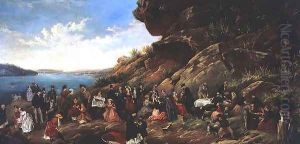Montague Scott Paintings
Montague Scott was an Australian artist whose work spanned the late 19th and early 20th centuries, a period that was transformative for the Australian art scene. Born in 1885, Scott's artistic journey began in an era when Australian art was beginning to forge its own identity, moving away from European influences and seeking to capture the unique landscapes, light, and essence of the Australian continent. His contributions to this emerging narrative of Australian art were significant, as he captured both the rugged natural beauty of the country and the burgeoning urban scenes.
Scott's early life was marked by a passion for the Australian landscape, which would become a central theme in his work. He was educated at the National Art School in Sydney, where he honed his skills in both painting and drawing. His style was influenced by the Heidelberg School, a movement that emphasized the importance of plein air painting and sought to capture the Australian landscape's distinctive light and color. Scott's work, however, was not limited to landscapes; he also painted portraits and urban scenes, showcasing his versatility as an artist.
Throughout his career, Montague Scott exhibited widely, both within Australia and internationally, earning recognition and accolades for his contributions to Australian art. His paintings were celebrated for their vibrant colors, detailed representation, and the ability to evoke the spirit of the Australian landscape and its people. Despite his success, Scott remained committed to his artistic development, continually exploring new techniques and subjects.
The interwar period was a particularly productive time for Scott, as he captured the changing Australian society with its growing cities and evolving landscapes. His depiction of Sydney, in particular, provides a valuable visual record of the city's development during the early 20th century.
Montague Scott's legacy extends beyond his paintings. He was an influential figure in the Australian art community, mentoring young artists and contributing to the development of art societies and exhibitions. His death in 1945 marked the end of a career that had significantly impacted the Australian art scene, leaving behind a body of work that continues to be celebrated for its contribution to the national narrative of Australia's cultural and natural heritage.
